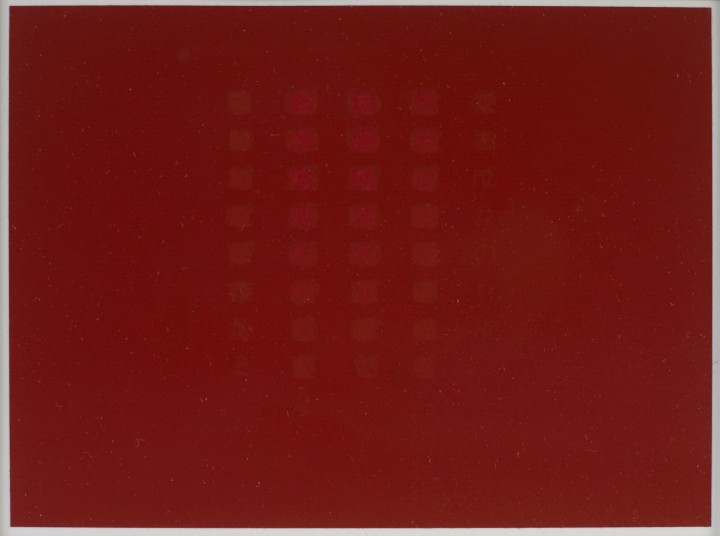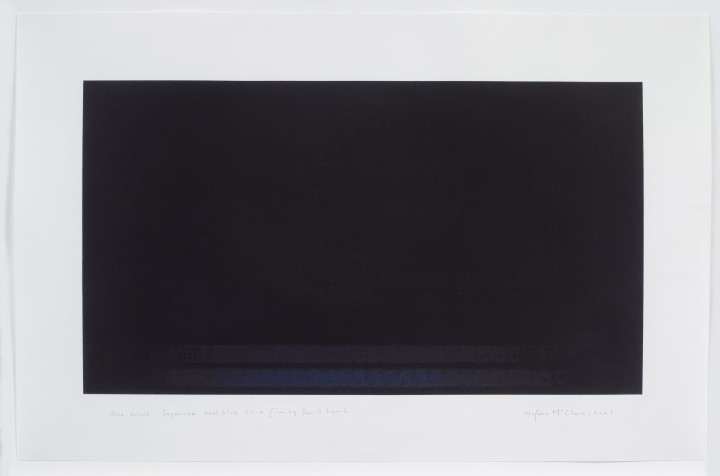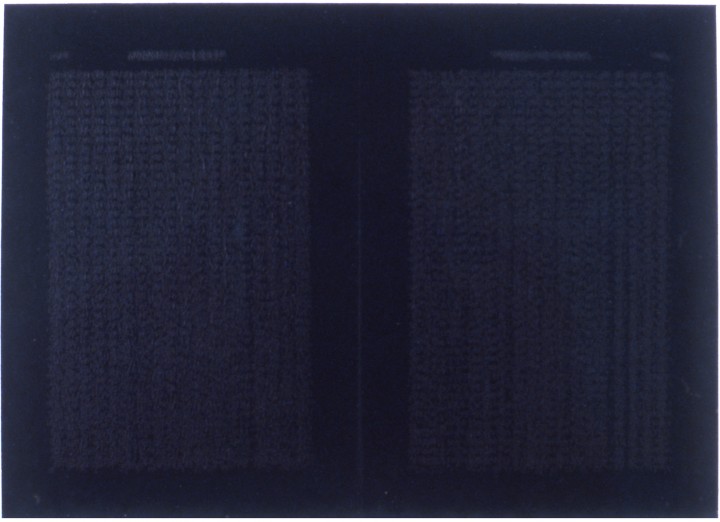
Stefana McClure is concerned with the confluence of forms as extrapolated from language and its expression. In her practice as a visual artist, she takes written text and makes it manifest in aesthetic form, allowing for a curious palimpsest to occur—as the minimalist bands of color or hyper-detailed designs engage the viewer, the realization that the abstraction is a tangible manifestation of poem, prose, or dialogue is striking. The viewer is liberated from the trappings of particular meaning or message, left instead with a sublime layout of language, the capture of the unseen composition of letters and words as stretched across temporal and spatial enunciation.

In her Films on Paper series, McClure utilizes colored transfer paper as a surface upon which to relentlessly accumulate the subtitles of a film, faithfully tracing each letter in its original typeface and screen placement onto a single intimately scaled page or series of pages. Often copies of Japanese subtitles for English-language films, the characters stack upon themselves, solidifying into shimmering bands of near-formless markings at the paper’s edge. These have been described as “light bands,” and rightfully so—they glow from the page, exuding a permanence not typically associated with the fleeting language of film, a time-based medium. An Inn in Tokyo: Intertitles to a silent film by Yasujiro Ozu (2003) is transferred from a 1935 film known for its subtle acting and powerful visuals invoking the struggle with depression and poverty in a small, honorable family. The condensed nature of the image here indirectly alludes to the relative simplicity of the silent film era, when language was an interruption and not the focus of the largely visual narrative. Intertitles, rather than simply filling in characters’ words, pause the visual action to provide a subjective narrative description; similarly, McClure offers a removed, condensed image as a source from which to intuit the film, aesthetically.

In works that capture the running subtitles of a film—such as Blue Velvet: Japanese subtitles to a film by David Lynch (2001)—the bands of form appear denser, as subtitles simultaneously capture the spoken arc of action and narration. In a way, subtitles provide a more objective translation of the world of the film, though mistakes can occur as a character’s particular words become lost in translation. In The Postman Always Rings Twice, a series of drawings based on the Japanese translation of a novel by James M. Cain (2005), five sheets of paper are entirely consumed by McClure’s faithful, painstaking tracing of the entire novel. While a Western viewer might sense an adaptation into Japanese from the faint vertical thrust of the markings, the dual monoliths of each page spread also share an uncanny formal affinity with the original English volume, capturing even the pagination and titling in the block header. The intrigue of the novel is muted, scrubbed away by McClure’s hand, its meaning buried within a literal run-down of form across the page.

Together, these transcendent, luminescent drawings represent three hours and twenty minutes of film, and an additional hundred or so pages of text—all in deceptively simple, seductive form. In her Films on Paper, McClure has effectively neutralized stories of poverty and imprisonment, sadism and murder, and sexuality and violence, respectively. Set against lushly colored grounds, the act of tracing transfer takes away color, continually removing color saturation until the register of language appears to glow. Each utterance, narration, or word is thus endlessly translated into a single form, abstracted from the specificity of geography and dialect into a universal, minimal form. These collected works speak of the universality of language—the blurred un-reading of each word affirming the dictum of accumulation over diction.
Whereas the structural rigor of filmic subtitling creates, through McClure’s hand, an even, measured body of work, the same principles applied to poetry engender something radically different: formless forms, patterns and explosions of cadence. Digging (from Death of a Naturalist): a poem by Seamus Heaney (2006) is neither a transcription nor an abstraction of that text; it is rather something of a visual translation of a synesthetic memory of the poem—its words and letters and spaces. McClure has taken away from “Digging” its immediate readability, instead emphasizing the poem’s visual structure through a systematized process acted upon an especially impressionable material.
Between my finger and my thumb/The squat pen rests; as snug as a gun—Seamus Heaney’s 1966 poem “Digging” begins with the assertion and reminder of the author’s chosen implement, the pen. While authors and artists alike regularly originate their drawings and writings with the pen, McClure instead utilized 88-character typeballs, organized spheres of letters and symbols from old electric typewriters, to make the marks of this drawing. McClure fastened the typewriter elements to the tips of professional typists’ gloved fingers, directing them in an exact iteration of the poem, word by word, pantomiming a keyboard upon the Teflon surface of the drawing. In selecting Teflon, an unusual support for a work of art, McClure capitalizes on the medium’s malleability: a nearly frictionless material, the synthetic captures and records the vestiges of touch and marking. Thus the drawing is made not with ink but with the memory of each stroke.
As impressions accumulate, marks are blackened by the fading and eventual erosion of the Teflon surface. Frequency of keystroke—letter, punctuation, or, perhaps, the space bar—is manifest in the darkening clouds of the drawing. The actual poem—its meaning, its word choice, its weight—is replaced by the poem’s visual structure, its accretions reminiscent of poised hands. Formal subtlety can also be traced in the Films on Paper, yet the stroke-by-stroke accrual therein allows for the unveiling of a distinct line. In pointed contrast, through Digging McClure has replaced the calculation and obsessive mimesis of the Films with a looser, chance-based translation of the rhythms of poetry. There is a tactile rhythm here that is absent in the Films; where Heaney describes the titular act of digging as a “squelch and slap,” so McClure captures the clack and clutter of the act of typewriting. Abstract yet accurate, the mysterious ebb and flow of letters and numbers coalesces into the poem’s transference, at times ethereal, at times dense.
Digging is one in a series of transposed poems and texts, each a discrete and easily distinguishable image, its layers both reconstructing and clouding the text that is literally at hand. Marks that initially seem the results of chance are thus revealed as indexes of the text—of its duration and of any repetition found within it. “Digging” becomes Digging, transferred and condensed in its entirety to one image, one reading, one moment. In each of her works on view here, McClure obliterates any semblance of the passage of time, all while transforming words of various context into shimmering, ghostly recollections—their function passing fluidly into form.
Stefana McClure Biography